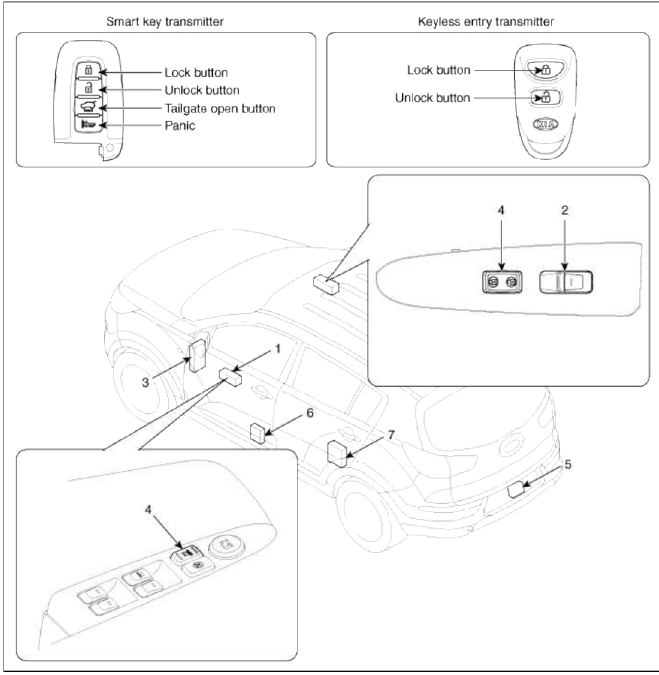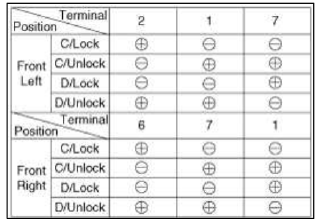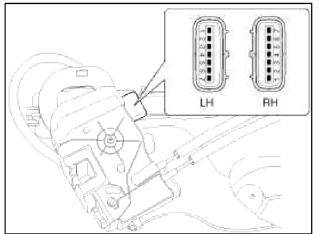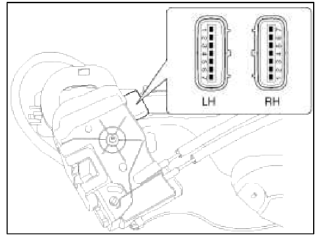Kia Sportage: Components and Components Location | Power Door Lock Actuators
Component Location

- Driver power window switch
- Assist power window switch
- SJB (Smart Junction Box)
- Door lock switch
- Tailgate lock actuator & switch
- Front door lock actuator & switch
- Rear door lock actuator & switch
Power Door Lock Actuators
Repair procedures
Inspection
Front Door Lock Actuator
1. Remove the front door trim.
(Refer to the BD group - "Front door")
2. Remove the front door module.
(Refer to the BD group - "Front door")
3. Disconnect the connectors from the actuator.

4. Check actuator operation by connecting power and ground according to the table. To prevent damage to the actuator, apply battery voltage only momentarily.
[Central Lock]
![[Double Lock]](images/books/1921/11/index%201.png)
[Double Lock]

Rear Door Lock Actuator
1. Remove the rear door trim.
(Refer to the BD group - "Rear door")
2. Remove the rear door module.
(Refer to the BD group - "Rear door")
3. Disconnect the connectors from the actuator.

4. Check actuator operation by connecting power and ground according to the table. To prevent damage to the actuator, apply battery voltage only momentarily.
[Central Lock]
![[Double Lock]](images/books/1921/11/index%204.png)
[Double Lock]

Tailgate Lock Actuator Inspection
1. Remove the tailgate trim.
(Refer to the BD group - "Tailgate")
2. Disconnect the 4P connector from the actuator.

3. Check actuator operation by connecting power and ground according to the table. To prevent damage to the actuator, apply battery voltage only momentarily.

Front Door Lock Switch
1. Remove the front door trim.
(Refer to the BD group - "Front door")
2. Remove the front door module.
(Refer to the BD group - "Front door")
3. Disconnect the connectors from the actuator

4. Check for continuity between the terminals in each switch position when inserting the key into the door according to the table.
[Central Lock]
![[Double Lock]](images/books/1921/11/index%209.png)
[Double Lock]

Rear Door Lock Switch
1. Remove the rear door trim.
(Refer to the BD group - "Rear door")
2. Remove the rear door module.
(Refer to the BD group - "Rear door")
3. Disconnect the connectors from the actuator.

4. Check for continuity between the terminals in each switch position according to the table.
[Central Lock]

Tailgate Switch
1. Remove the tailgate trim.
(Refer to the BD group - "Tailgate")
2. Disconnect the 4P connector from the actuator.

3. Check for continuity between the terminals in each switch position according to the table.

READ NEXT:
 Power Door Lock Switch
Power Door Lock Switch
Repair procedures
Inspection
Driver Power Door Lock Switch
1. Disconnect the negative battery terminal.
2. Remove the front door trim.
(Refer to the BD group - "Front door")
 Power Door Mirrors
Power Door Mirrors
Components and Components Location
Component Location
Power door mirror
Power door mirror
switch
Power Door Mirror Switch
Schematic Diagrams
Circuit Diagram
Connecto
SEE MORE:
 Electrical Equipment (U.S. only)
Electrical Equipment (U.S. only)
The electrical system of your vehicle is
designed to perform under all reasonably
expected operating conditions.
However, before any additional electrical
equipment is installed in your vehicle,
consult an Authorized Kia Dealer, in
order to ensure that you do not void
your warranty.
Cert
 Closing the liftgate
Closing the liftgate
To close the liftgate, lower and push
down the liftgate firmly. Make sure
that the liftgate is securely latched.
WARNING
Make sure your hands, feet and other
parts of your body are safely out of the
way before closing the liftgate.
WARNING
Exhaust fumes
The liftgate lid should be
Content
- Home
- Kia Sportage - Fifth generation (NQ5) - (2022-2025) - Owner's Manual
- Kia Sportage - Second generation (JEKM) (2005-2015) - Body Workshop Manual
- Kia Sportage Third generation (SL) - (2011-2016) - Service and Repair Manual
- Sitemap
- Top articles